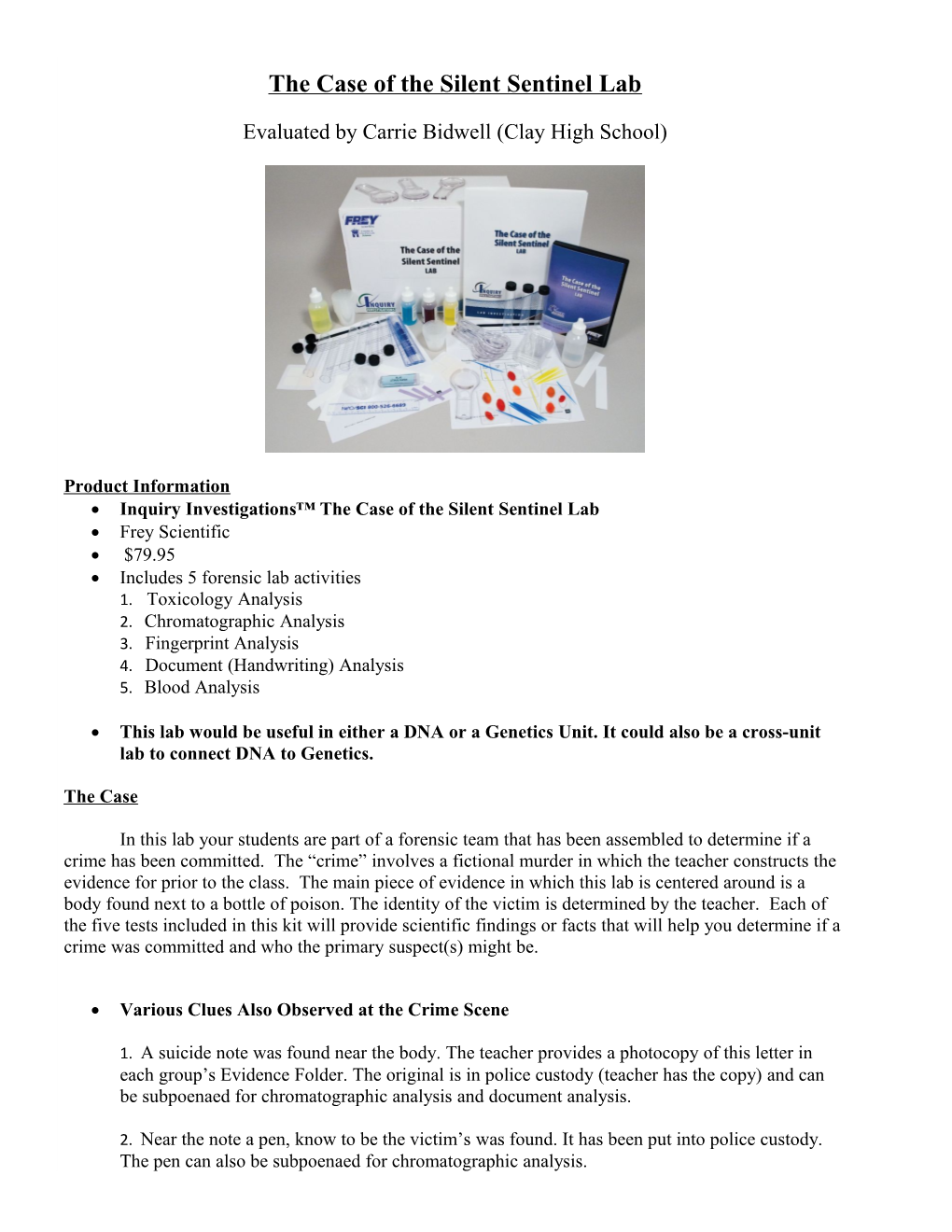The Case of the Silent Sentinel Lab
Evaluated by Carrie Bidwell (Clay High School)
Product Information
· Inquiry Investigations™ The Case of the Silent Sentinel Lab
· Frey Scientific
· $79.95
· Includes 5 forensic lab activities
1. Toxicology Analysis
2. Chromatographic Analysis
3. Fingerprint Analysis
4. Document (Handwriting) Analysis
5. Blood Analysis
· This lab would be useful in either a DNA or a Genetics Unit. It could also be a cross-unit lab to connect DNA to Genetics.
The Case
In this lab your students are part of a forensic team that has been assembled to determine if a crime has been committed. The “crime” involves a fictional murder in which the teacher constructs the evidence for prior to the class. The main piece of evidence in which this lab is centered around is a body found next to a bottle of poison. The identity of the victim is determined by the teacher. Each of the five tests included in this kit will provide scientific findings or facts that will help you determine if a crime was committed and who the primary suspect(s) might be.
· Various Clues Also Observed at the Crime Scene
1. A suicide note was found near the body. The teacher provides a photocopy of this letter in each group’s Evidence Folder. The original is in police custody (teacher has the copy) and can be subpoenaed for chromatographic analysis and document analysis.
2. Near the note a pen, know to be the victim’s was found. It has been put into police custody. The pen can also be subpoenaed for chromatographic analysis.
3. Fingerprints have also been recovered at the scene. Forensic technicians have lifted four latent (hidden) fingerprints from the poison bottle. These latent fingerprints have been grouped on a Fingerprint Evidence Sheet and placed in your Evidence Folder. The fingerprints are used for the fingerprint analysis.
4. Blood is also found near the body. “Tests” done prior to the students arrival to the crime scene confirm that drops found where the body was discovered are human blood. This blood is used in the blood-type analysis.
5. The students are given a urine sample from the victim to use for the toxicology analysis. The students will determine if poison was present in the victim’s body. The bottle of poison is in police custody so students must also subpoena the poison to compare results.
· Materials Provided
-Anti- A serium (simulated)
-Anti-B serum (simulated)
-Blood typing trays
-Chromatography vials
-Chromatography paper strips
-Finger printing cards, inkless
-Magnifying glasses
-Medicine cups
-Poison test strips (simulated)
-Rulers
- Samples
-Poison (simulated)
-Urine (simulated)
-Blood (simulated)
-Striring stick- blue and yellow
· Materials Needed but not provided
-Envelopes (10)
- Paper towels
- Pencils
-Permanent marking pen
-Transparent tape
-Goggles (suggested)
Lab Evaluation
Forensics is a high interest topic and this lab will appeal to teacher and student alike. This lab activity itself is very engaging and will very easily lead to classrooms discussions about the processes “real” forensic scientists use.
From a teacher’s standpoint, this lab involves some time to initially set-up. The lab instruction manual lists the amount of time it takes to prepare each of the five parts. After the initial assembly of the lab is complete however, this same “crime” scene can be used in future classes. In fact, teachers may want to change the results of the “crime” between classes to vary results . Also, once the lab is created, most of the work is student driven. Students have to work with minimal teacher assistance to run the different analysis activity and most of the work is inquiry based. Students must complete all of the forensic tests in order to create a clear picture of the evidence. Upon completion of this lab, it is recommended to have the students write formal lab reports to present their findings.
The Case of the Silent Sentinel Lab
